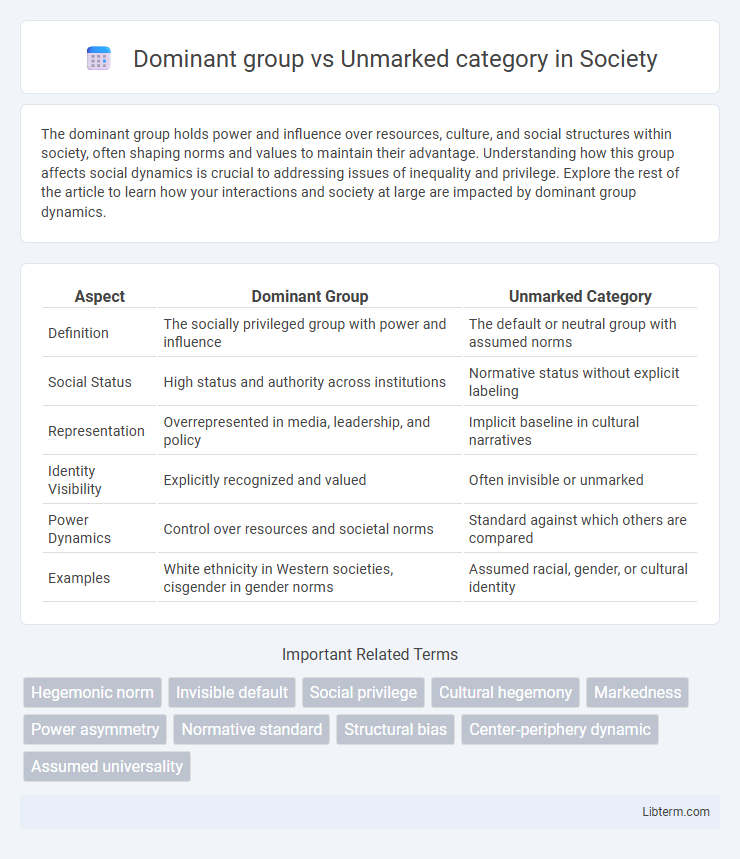The dominant group holds power and influence over resources, culture, and social structures within society, often shaping norms and values to maintain their advantage. Understanding how this group affects social dynamics is crucial to addressing issues of inequality and privilege. Explore the rest of the article to learn how your interactions and society at large are impacted by dominant group dynamics.
Table of Comparison
| Aspect | Dominant Group | Unmarked Category |
|---|---|---|
| Definition | The socially privileged group with power and influence | The default or neutral group with assumed norms |
| Social Status | High status and authority across institutions | Normative status without explicit labeling |
| Representation | Overrepresented in media, leadership, and policy | Implicit baseline in cultural narratives |
| Identity Visibility | Explicitly recognized and valued | Often invisible or unmarked |
| Power Dynamics | Control over resources and societal norms | Standard against which others are compared |
| Examples | White ethnicity in Western societies, cisgender in gender norms | Assumed racial, gender, or cultural identity |
Understanding Dominant Groups
Dominant groups hold social, economic, or political power that shapes cultural norms and defines the unmarked category, often perceived as the default or standard in society. Understanding dominant groups requires analyzing how their influence perpetuates systemic advantages, reinforcing inequality and marginalizing other identities. Examining dominant group dynamics reveals the mechanisms through which power maintains social hierarchies and controls representations of normality.
Defining the Unmarked Category
The unmarked category represents the default or normative group against which other groups are compared, often remaining invisible or neutral in social and linguistic contexts. It serves as the implicit standard, shaping perceptions and reinforcing the dominance of the dominant group by positioning its characteristics as normal or universal. Understanding the unmarked category reveals how power dynamics and cultural biases are embedded in language and social structures, maintaining systemic inequalities.
Historical Origins and Context
The dominant group concept emerged from social and political history, identifying populations holding cultural, economic, or political power, often institutionalized through colonialism and systemic inequality. The unmarked category originated in linguistics and cultural studies, describing default identities or norms assumed as standard in social contexts, frequently reflecting dominant group traits. Historical context reveals that the unmarked category often invisibilizes marginalized groups by positioning the dominant group's characteristics as universal or normative.
Power Dynamics in Social Structures
Dominant groups maintain power through controlling resources, cultural norms, and institutional structures, reinforcing social hierarchies that marginalize unmarked categories, often viewed as the societal default or norm. The unmarked category benefits from invisibility and normalization, which obscures its privileged status while perpetuating systemic inequalities. Power dynamics in social structures thus rely on the continuous legitimization of dominant group dominance and the naturalization of unmarked categories.
Representation in Media and Culture
The dominant group often shapes media and cultural narratives, establishing the unmarked category as the normative standard against which others are measured. Representation in media tends to marginalize or stereotype non-dominant groups, reinforcing social hierarchies and limiting diverse perspectives. This dynamic impacts identity formation and perpetuates systemic inequalities by normalizing the experiences and values of the dominant group while rendering others as deviations.
Language Patterns and Unmarked Norms
Dominant groups often establish unmarked categories in language, positioning their own social norms, behaviors, and identities as the default or standard, which reinforces existing power structures through everyday communication. Language patterns such as pronoun usage, vocabulary choices, and syntactic structures frequently reflect these unmarked norms, marginalizing alternative perspectives or identities by rendering them marked or exceptional. This linguistic phenomenon perpetuates social hierarchies by normalizing the dominant group's worldview and invisibilizing subordinate groups in discourse.
Effects on Marginalized Groups
The dominant group holds societal power, shaping norms that render marginalized groups as the unmarked category's contrast, often leading to systemic exclusion and invisibility. Marginalized groups face unequal access to resources, representation, and opportunities, reinforcing social hierarchies and limiting upward mobility. This dynamic perpetuates discrimination and cultural erasure, impacting mental health, economic status, and political influence within marginalized communities.
Impacts in Workplace and Education
Dominant groups in workplaces and educational settings often shape norms and expectations, marginalizing individuals from unmarked categories and limiting their access to opportunities and resources. This dynamic reinforces systemic biases, leading to disparities in representation, participation, and recognition. Addressing these imbalances requires intentional policies that promote inclusivity and equitable support for underrepresented groups.
Challenging the Status Quo
Dominant groups maintain power structures by normalizing their traits as the unmarked category, effectively marginalizing other identities. Challenging the status quo involves recognizing and deconstructing these unmarked categories to reveal hidden biases and systemic inequalities. Activism and critical discourse play crucial roles in disrupting dominant narratives and promoting inclusivity.
Toward Greater Visibility and Inclusion
The dominant group often shapes societal norms, making the unmarked category invisible and reinforcing implicit biases. Increasing visibility and inclusion requires challenging the default status of unmarked categories by amplifying marginalized voices and promoting equitable representation. Inclusive frameworks foster recognition of diversity, ensuring that all groups are acknowledged and valued equally in social, cultural, and institutional contexts.
Dominant group Infographic

 libterm.com
libterm.com